The global general equipment rental services market is projected to reach USD 79,779.4 million by 2035, recording an absolute increase of USD 34,381.7 million over the forecast period. The market is valued at USD 45,397.7 million in 2025 and is set to rise at a CAGR of 5.8% during the assessment period. The market size is expected to grow by nearly 1.8 times during the same period, supported by increasing construction activities worldwide, driving demand for efficient equipment rental systems and growing investments in infrastructure development and construction projects globally. High initial capital requirements for equipment procurement and complex maintenance schedules for advanced rental fleets may pose challenges to market expansion.
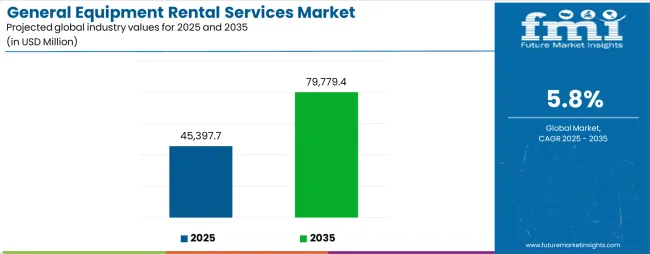
Between 2025 and 2030, the general equipment rental services market is projected to expand from USD 45,397.7 million to USD 60,181.4 million, resulting in a value increase of USD 14,783.7 million, which represents 43.0% of the total forecast growth for the decade. This phase of development will be shaped by rising demand for construction and infrastructure development solutions, product innovation in rental technologies and fleet management systems, as well as expanding integration with smart equipment monitoring and IoT platforms. Companies are establishing competitive positions through investment in advanced rental fleet technologies, energy-efficient solutions, and strategic market expansion across construction, mining, and industrial applications.
From 2030 to 2035, the market is forecast to grow from USD 60,181.4 million to USD 79,779.4 million, adding another USD 19,598.0 million, which constitutes 57.0% of the ten-year expansion. This period is expected to be characterized by the expansion of specialized equipment rental systems, including intelligent fleet management platforms and integrated monitoring solutions tailored for specific industry applications, strategic collaborations between equipment providers and construction companies, and an enhanced focus on operational efficiency and environmental friendliness. The growing focus on cost optimization and flexible asset utilization will drive demand for comprehensive equipment rental solutions across diverse industrial applications.
| Metric | Value |
|---|---|
| Market Value (2025) | USD 45,397.7 million |
| Market Forecast Value (2035) | USD 79,779.4 million |
| Forecast CAGR (2025 to 2035) | 5.8% |
The general equipment rental services market grows by enabling businesses to optimize capital expenditure while accessing the latest equipment technologies without substantial upfront investments. Construction companies and industrial operators face mounting pressure to reduce operational costs and improve project efficiency, with equipment rental services typically requiring 40-60% less capital investment than equipment purchase alternatives, making rental solutions essential for competitive project execution.
The construction industry's need for flexible equipment access and project-specific machinery creates demand for comprehensive rental solutions that can provide specialized equipment, maintain operational readiness, and ensure seamless project execution without long-term equipment ownership commitments. Government initiatives promoting infrastructure development and smart construction practices drive adoption in construction, mining, and industrial applications, where reliable access to equipment has a direct impact on project completion timelines and operational efficiency. Equipment availability constraints during peak construction seasons and the complexity of managing diverse rental fleet requirements may limit service accessibility among smaller contractors and developing regions with limited rental infrastructure.
The market is segmented by equipment type, application, and region. By equipment type, the market is divided into activated carbon filtration type, membrane filtration type, and others. Based on the application, the market is categorized into the construction industry, mining H&E equipment, and general rental & sales. Regionally, the market is divided into Asia Pacific, Europe, North America, and other key regions.
The membrane filtration type segment represents the dominant force in the equipment rental services market, capturing approximately 52.4% of total market share in 2025. This advanced technology category encompasses equipment featuring sophisticated filtration and processing capabilities, including high-efficiency particulate air (HEPA) systems and advanced membrane technologies that enable superior performance monitoring and environmental compliance procedures. The membrane filtration segment's market leadership stems from its superior operational capabilities, with equipment capable of handling diverse industrial applications while maintaining consistent performance standards and environmental compliance across all operational conditions.
The activated carbon filtration type segment maintains a substantial 28.7% market share, serving customers who require reliable equipment performance with enhanced environmental protection features. These systems offer cost-effective solutions for medium-scale operations while providing sufficient performance capabilities to meet regional construction and industrial demands. The remaining market segments, categorized as specialty or hybrid systems, account for approximately 18.9% of the market, serving niche applications requiring specific equipment configurations or specialized operational parameters.
Key technological advantages driving the membrane filtration segment include:
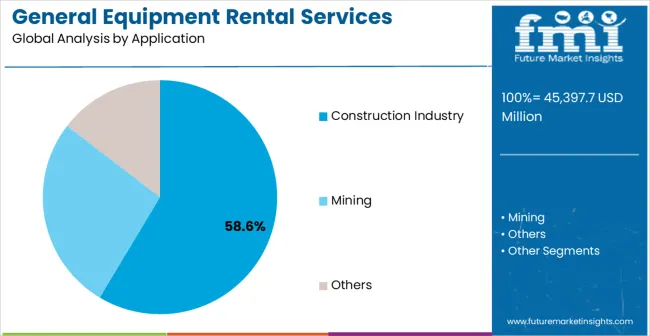
Construction industry applications dominate the general equipment rental services market with approximately 58.6% market share in 2025, reflecting the critical role of equipment rental in supporting global infrastructure development and construction project execution worldwide. The construction segment's market leadership is reinforced by increasing urbanization trends, government infrastructure investments, and rising demand for flexible equipment access solutions in commercial and residential building projects across developed and emerging markets.
The mining H&E equipment segment represents the second-largest application category, capturing 24.3% market share through specialized equipment requirements for heavy industrial operations, mining projects, and large-scale infrastructure development applications. This segment benefits from growing demand for high-capacity, specialized equipment that meets specific operational requirements, environmental compliance standards, and safety protocols in challenging operational environments.
The general rental & sales segment accounts for 17.1% market share, serving diverse industrial applications including manufacturing support, temporary installations, and specialized project requirements across multiple industry sectors.
Key market dynamics supporting application growth include:
The market is driven by three concrete demand factors tied to operational efficiency outcomes. First, construction industry growth and infrastructure development create increasing demand for flexible equipment access systems, with construction project requirements expanding by 15-20% annually in major developing countries worldwide, requiring comprehensive equipment rental infrastructure. Second, government initiatives promoting infrastructure development and smart construction drive increased adoption of rental solutions, with many countries allocating 8-12% of GDP toward infrastructure development by 2030. Third, technological advancements in equipment monitoring and fleet management enable more reliable and cost-effective rental solutions that reduce operational risks while improving project execution and equipment utilization standards.
Market restraints include high capital investment requirements for fleet establishment that can deter new market entrants from developing comprehensive rental operations, particularly in developing regions where funding for equipment procurement remains limited. Equipment availability constraints during peak construction seasons pose another significant challenge, as demand fluctuations can create service gaps and project delays, potentially causing increased project costs and timeline extensions. Maintenance complexity and technical expertise requirements across different equipment types create additional operational challenges for rental providers, demanding ongoing investment in technical capabilities and service infrastructure.
Key trends indicate accelerated adoption in Asia-Pacific markets, particularly China and India, where rapid infrastructure development and construction activity drive comprehensive equipment rental system expansion. Technology integration trends toward smart equipment monitoring solutions with IoT connectivity, predictive maintenance capabilities, and integrated fleet management systems enable proactive service approaches that reduce equipment downtime and operational costs. The market thesis could face disruption if alternative construction methods or significant changes in project execution approaches minimize reliance on traditional equipment rental services.
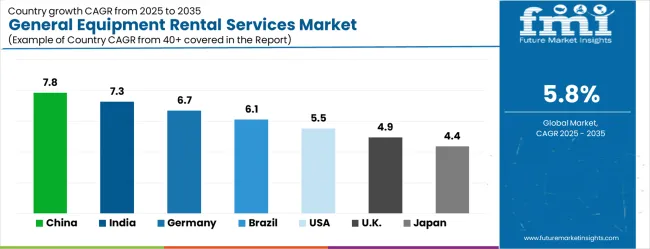
| Country | CAGR (2025-2035) |
|---|---|
| China | 7.8% |
| India | 7.3% |
| Germany | 6.7% |
| Brazil | 6.1% |
| USA | 5.5% |
| UK | 4.9% |
| Japan | 4.4% |
The general equipment rental services market is gaining momentum worldwide, with China taking the lead thanks to massive infrastructure expansion and government-backed construction modernization programs. Close behind, India benefits from expanding urbanization activities and smart city initiatives, positioning itself as a strategic growth hub in the Asia-Pacific region. Germany shows steady advancement, where integration of advanced equipment technologies strengthens its role in the European construction equipment supply chain. Brazil is focusing on infrastructure modernization and construction development, signaling an ambition to capitalize on the growing opportunities in South American construction markets. Meanwhile, the U.S. stands out for its advanced technology adoption in existing rental operations, and the U.K. and Japan continue to record consistent progress in equipment modernization. Together, China and India anchor the global expansion story, while the rest build stability and diversity into the market's growth path.
The report covers an in-depth analysis of 40+ countries, top-performing countries are highlighted below.
China demonstrates the strongest growth potential in the General Equipment Rental Services Market with a CAGR of 7.8% between 2025 and 2035. The country's leadership position stems from massive infrastructure development projects, government-backed construction modernization programs, and stringent efficiency regulations driving the adoption of advanced rental solutions. Growth is concentrated in major metropolitan areas, including Beijing, Shanghai, Guangzhou, and Shenzhen, where construction projects and infrastructure development are implementing advanced equipment rental solutions for enhanced operational efficiency and project execution. Distribution channels through state-owned construction enterprises and government-approved contractors expand deployment across infrastructure projects and urban development initiatives. The country's Belt and Road Initiative provides policy support for construction modernization, including advanced equipment rental system adoption.
Key market factors:
In Mumbai, Delhi, Bangalore, and Chennai, the adoption of comprehensive equipment rental services is accelerating across construction projects and infrastructure development initiatives, driven by rapid urbanization and government smart city programs. The market demonstrates strong growth momentum with a CAGR of 7.3% from 2025 to 2035, linked to comprehensive infrastructure development and increasing focus on cost-effective construction solutions. Indian construction companies are implementing advanced rental services and equipment platforms to enhance operational efficiency while meeting growing demand in expanding urban development and industrial sectors. The country's National Infrastructure Pipeline creates demand for equipment rental solutions, while increasing focus on project efficiency drives adoption of advanced equipment management systems.
Germany's advanced construction sector demonstrates sophisticated implementation of equipment rental services, with documented case studies showing 35% operational efficiency improvements in construction operations through intelligent equipment management platforms. The market maintains steady growth through focus on Industry 4.0 integration and compliance, with a CAGR of 6.7% during the forecast period. The country's construction infrastructure in major industrial centers, including Munich, Berlin, Hamburg, and Frankfurt, showcases integration of advanced rental technologies with existing construction systems, leveraging expertise in mechanical engineering and construction technologies. German construction companies emphasize precision and quality standards, creating demand for high-performance rental solutions that support continuous improvement initiatives and operational optimization requirements.
Key development areas:
Brazil's market expansion is driven by diverse construction demand, including residential development in São Paulo and Rio de Janeiro, infrastructure projects in Brasília and other major cities, and comprehensive construction modernization across multiple states. The country demonstrates promising growth potential with a CAGR of 6.1% between 2025 and 2035, supported by federal government infrastructure investment programs and state-level construction development initiatives. Brazilian construction companies face implementation challenges related to equipment financing constraints and technical expertise availability, requiring phased deployment approaches and financing support from development banks. The growing infrastructure demands and construction efficiency requirements create compelling business cases for equipment rental adoption, particularly in urban areas where operational efficiency has a direct impact on project competitiveness.
Market characteristics:
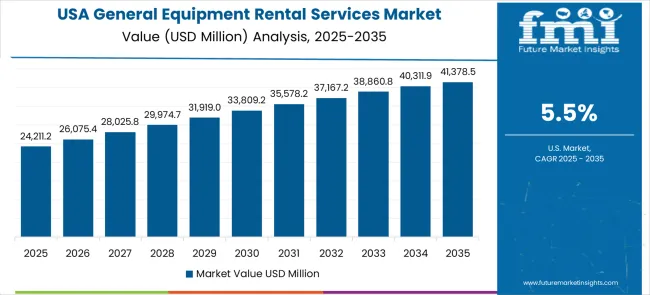
The U.S. market leads in advanced equipment rental innovation based on integration with intelligent construction systems and smart project technologies for enhanced operational efficiency. The country shows strong potential with a CAGR of 5.5% through 2035, driven by the modernization of existing construction infrastructure and the expansion of technology-enabled rental facilities in major metropolitan areas, including New York, Los Angeles, Chicago, and Houston. American construction companies are adopting intelligent rental systems for operational efficiency improvement and regulatory compliance, particularly in regions with strict environmental standards and aging infrastructure requiring comprehensive upgrades. Technology deployment channels through established construction contractors and direct provider relationships expand coverage across construction facilities and project operators.
Leading market segments:
In London, Manchester, Birmingham, and Glasgow, construction facilities are implementing comprehensive equipment rental solutions to modernize aging project infrastructure and improve operational efficiency, with documented case studies showing a 28% reduction in project costs through advanced equipment management systems. The market shows moderate growth potential with a CAGR of 4.9% during the forecast period, linked to the ongoing modernization of construction facilities, infrastructure networks, and emerging smart construction projects in major cities. British construction companies are adopting intelligent rental and monitoring platforms to enhance equipment reliability while maintaining project quality standards demanded by clients and regulatory authorities. The country's established construction infrastructure creates demand for equipment upgrade and modernization solutions that integrate with existing project systems.
Market development factors:
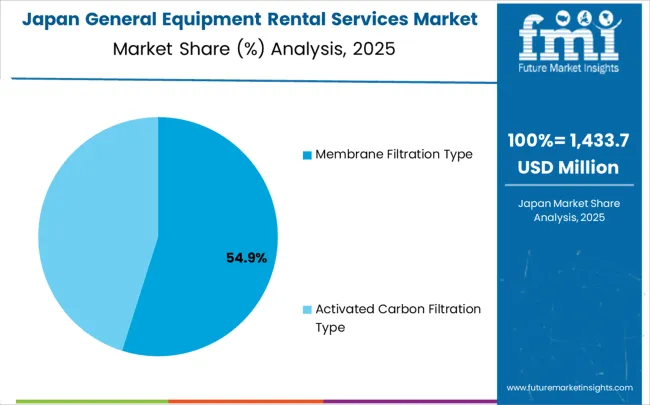
Japan's General Equipment Rental Services Market demonstrates sophisticated implementation focused on precision engineering and operational excellence optimization, with documented integration of advanced construction systems, achieving 30% improvement in project efficiency across construction and infrastructure facilities. The country maintains steady growth momentum with a CAGR of 4.4% between 2025 and 2035, driven by construction facilities' focus on quality standards and continuous improvement methodologies that align with lean construction principles applied to project operations. Major metropolitan areas, including Tokyo, Osaka, Nagoya, and Fukuoka, showcase advanced deployment of intelligent rental platforms where equipment systems integrate seamlessly with existing construction control systems and comprehensive quality management programs.
Key market characteristics:
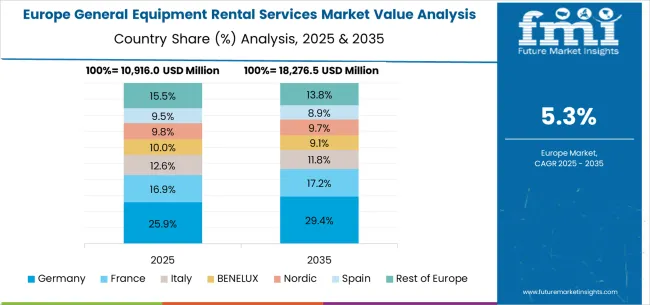
The general equipment rental services market in Europe is projected to grow from USD 11,349.4 million in 2025 to USD 19,944.9 million by 2035, registering a CAGR of 5.8% over the forecast period. Germany is expected to maintain its leadership position with a 31.8% market share in 2025, declining slightly to 31.2% by 2035, supported by its extensive construction infrastructure and major industrial centers, including Munich, Berlin, and Frankfurt construction facilities.
The United Kingdom follows with an 18.2% share in 2025, projected to reach 18.6% by 2035, driven by comprehensive construction modernization programs in London, Manchester, and other industrial areas implementing advanced equipment systems. France holds a 16.5% share in 2025, expected to maintain 16.1% by 2035 through the ongoing development of construction facilities and infrastructure networks. Italy commands a 14.9% share, while Spain accounts for 11.4% in 2025. The Rest of Europe region is anticipated to gain momentum, expanding its collective share from 7.2% to 8.4% by 2035, attributed to increasing equipment rental adoption in Nordic countries and emerging Eastern European construction facilities implementing infrastructure development programs.
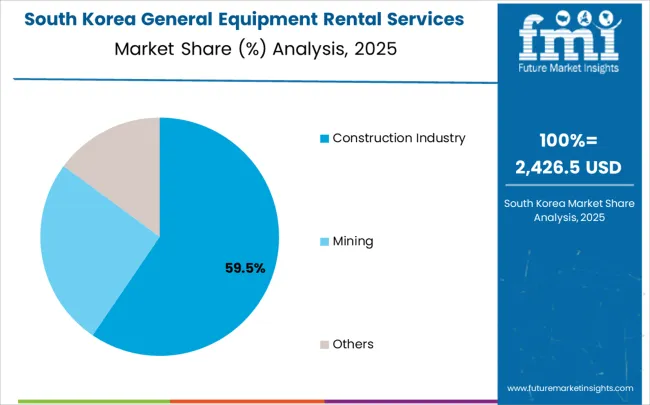
The South Korean General Equipment Rental Services Market is characterized by strong international technology provider presence, with companies like LOTTE Rental Co., Ltd., Herc Rentals, and Finning International Inc. maintaining dominant positions through comprehensive system integration and maintenance services capabilities for construction facilities and industrial project applications. The market is demonstrating a growing focus on localized technical support and rapid response capabilities, as Korean construction companies increasingly demand customized solutions that integrate with domestic construction infrastructure and advanced project control systems deployed across the Seoul Metropolitan Area and other major industrial cities. Local construction equipment companies and regional service integrators are gaining market share through strategic partnerships with global providers, offering specialized services including technical training programs and certification services for equipment operators. The competitive landscape shows increasing collaboration between multinational equipment rental companies and Korean construction technology specialists, creating hybrid service models that combine international mechanical engineering expertise with local market knowledge and customer relationship management.
The General Equipment Rental Services Market features approximately 35-45 meaningful players with moderate concentration, where the top three companies control roughly 28-35% of global market share through established equipment portfolios and extensive construction industry relationships. Competition centers on equipment availability, service capabilities, and operational efficiency rather than price competition alone.
Market leaders include LOTTE Rental Co., Ltd., Herc Rentals, and Finning International Inc., which maintain competitive advantages through comprehensive equipment solution portfolios, global service networks, and deep expertise in the construction and industrial sectors, creating high switching costs for customers. These companies leverage installed equipment relationships and ongoing service contracts to defend market positions while expanding into adjacent construction and industrial applications.
Challengers encompass Liebherr-International AG and Kanamoto Co., Ltd., which compete through specialized equipment solutions and strong regional presence in key construction markets. Technology specialists, including Maxim Crane Works, L.P., Kiloutou, and Sarens n.v., focus on specific equipment technologies or vertical applications, offering differentiated capabilities in heavy equipment, specialized machinery, and project-specific solutions.
Regional players and emerging service providers create competitive pressure through cost-effective solutions and rapid deployment capabilities, particularly in high-growth markets including China and India, where local presence provides advantages in customer support and regulatory compliance. Market dynamics favor companies that combine advanced equipment technologies with comprehensive service offerings that address the complete equipment lifecycle from deployment through ongoing maintenance and optimization.
General equipment rental services represent a critical capital optimization solution that enables construction companies, mining operators, and industrial facilities to access advanced machinery and specialized equipment without substantial upfront investments, typically requiring 40-60% less capital than equipment purchase alternatives. With the market projected to grow from USD 45,397.7 million in 2025 to USD 79,779.4 million by 2035 at a 5.8% CAGR, these services offer compelling advantages - flexible asset utilization, access to latest technologies, and project-specific equipment availability - making them essential for construction industry (58.6% market share), mining operations (24.3% share), and diverse industrial applications seeking alternatives to direct equipment ownership. Scaling market penetration and service quality requires coordinated action across infrastructure policy, industry standards, equipment manufacturers, rental service providers, and capital markets.
| Item | Value |
|---|---|
| Quantitative Units | USD 45,397.7 million |
| Equipment Type | Activated Carbon Filtration Type, Membrane Filtration Type, Others |
| Application | Construction Industry, Mining H&E Equipment, General Rental & Sales |
| Regions Covered | Asia Pacific, Europe, North America, Latin America, Middle East & Africa |
| Country Covered | China, India, Germany, Brazil, the U.S., the U.K., Japan, and 40+ countries |
| Key Companies Profiled | LOTTE rental co., ltd., Go Local Asheville, RMS Rentals, ATS Equipment Corporation, Herc Rentals, Finning International Inc., Liebherr-International AG, Kanamoto Co., Ltd., Maxim Crane Works, L.P., Kiloutou |
| Additional Attributes | Dollar sales by equipment type and application categories, regional adoption trends across Asia Pacific, Europe, and North America, competitive landscape with equipment providers and service integrators, construction facility requirements and specifications, integration with smart construction initiatives and IoT platforms, innovations in equipment rental technology and monitoring systems, and development of specialized applications with efficiency and quality capabilities. |
The global general equipment rental services market is estimated to be valued at USD 45,397.7 million in 2025.
The market size for the general equipment rental services market is projected to reach USD 79,779.4 million by 2035.
The general equipment rental services market is expected to grow at a 5.8% CAGR between 2025 and 2035.
The key product types in general equipment rental services market are membrane filtration type and activated carbon filtration type.
In terms of application, construction industry segment to command 58.6% share in the general equipment rental services market in 2025.






Our Research Products

The "Full Research Suite" delivers actionable market intel, deep dives on markets or technologies, so clients act faster, cut risk, and unlock growth.

The Leaderboard benchmarks and ranks top vendors, classifying them as Established Leaders, Leading Challengers, or Disruptors & Challengers.

Locates where complements amplify value and substitutes erode it, forecasting net impact by horizon

We deliver granular, decision-grade intel: market sizing, 5-year forecasts, pricing, adoption, usage, revenue, and operational KPIs—plus competitor tracking, regulation, and value chains—across 60 countries broadly.

Spot the shifts before they hit your P&L. We track inflection points, adoption curves, pricing moves, and ecosystem plays to show where demand is heading, why it is changing, and what to do next across high-growth markets and disruptive tech

Real-time reads of user behavior. We track shifting priorities, perceptions of today’s and next-gen services, and provider experience, then pace how fast tech moves from trial to adoption, blending buyer, consumer, and channel inputs with social signals (#WhySwitch, #UX).

Partner with our analyst team to build a custom report designed around your business priorities. From analysing market trends to assessing competitors or crafting bespoke datasets, we tailor insights to your needs.
Supplier Intelligence
Discovery & Profiling
Capacity & Footprint
Performance & Risk
Compliance & Governance
Commercial Readiness
Who Supplies Whom
Scorecards & Shortlists
Playbooks & Docs
Category Intelligence
Definition & Scope
Demand & Use Cases
Cost Drivers
Market Structure
Supply Chain Map
Trade & Policy
Operating Norms
Deliverables
Buyer Intelligence
Account Basics
Spend & Scope
Procurement Model
Vendor Requirements
Terms & Policies
Entry Strategy
Pain Points & Triggers
Outputs
Pricing Analysis
Benchmarks
Trends
Should-Cost
Indexation
Landed Cost
Commercial Terms
Deliverables
Brand Analysis
Positioning & Value Prop
Share & Presence
Customer Evidence
Go-to-Market
Digital & Reputation
Compliance & Trust
KPIs & Gaps
Outputs
Full Research Suite comprises of:
Market outlook & trends analysis
Interviews & case studies
Strategic recommendations
Vendor profiles & capabilities analysis
5-year forecasts
8 regions and 60+ country-level data splits
Market segment data splits
12 months of continuous data updates
DELIVERED AS:
PDF EXCEL ONLINE
General Intelligent Decision-Making Service Market Size and Share Forecast Outlook 2025 to 2035
General Purpose DC Contactor Market Size and Share Forecast Outlook 2025 to 2035
General Surgery Devices Market Insights – Demand and Growth Forecast 2025 to 2035
Generalized Anxiety Disorder Treatment Market Insights by Drug Class, Therapies, Distribution Channel, and Region 2035
General Purpose Electronic Test and Measurement Instruments Market Analysis and Forecast by Product, End Use, and Region Through 2035
Generalized Myasthenia Gravis Management Market - Growth & Treatment Advances 2025 to 2035
General Anesthesia Drugs Market Insights – Trends & Forecast 2025 to 2035
Equipment Management Software Market Size and Share Forecast Outlook 2025 to 2035
Equipment cases market Size and Share Forecast Outlook 2025 to 2035
Farm Equipment Market Forecast and Outlook 2025 to 2035
Golf Equipment Market Size and Share Forecast Outlook 2025 to 2035
Port Equipment Market Size and Share Forecast Outlook 2025 to 2035
Pouch Equipment Market Growth – Demand, Trends & Outlook 2025 to 2035
Garage Equipment Market Forecast and Outlook 2025 to 2035
Mining Equipment Industry Analysis in Latin America Size and Share Forecast Outlook 2025 to 2035
Subsea Equipment Market Size and Share Forecast Outlook 2025 to 2035
Pavers Equipment Market Size and Share Forecast Outlook 2025 to 2035
Tennis Equipment Market Analysis - Size, Share, and Forecast Outlook 2025 to 2035
Galley Equipment Market Analysis and Forecast by Fit, Application, and Region through 2035
Sorting Equipment Market Size and Share Forecast Outlook 2025 to 2035

Thank you!
You will receive an email from our Business Development Manager. Please be sure to check your SPAM/JUNK folder too.
Chat With
MaRIA